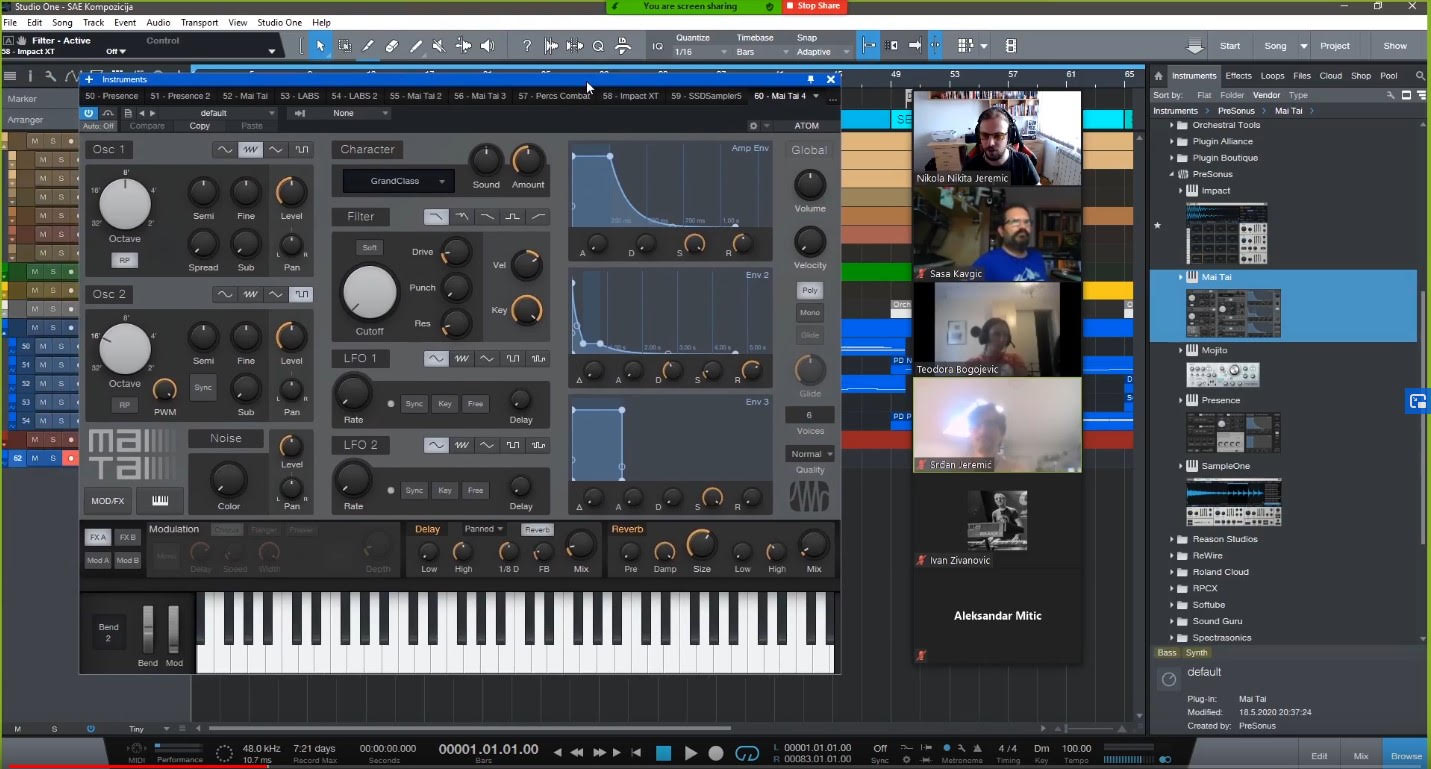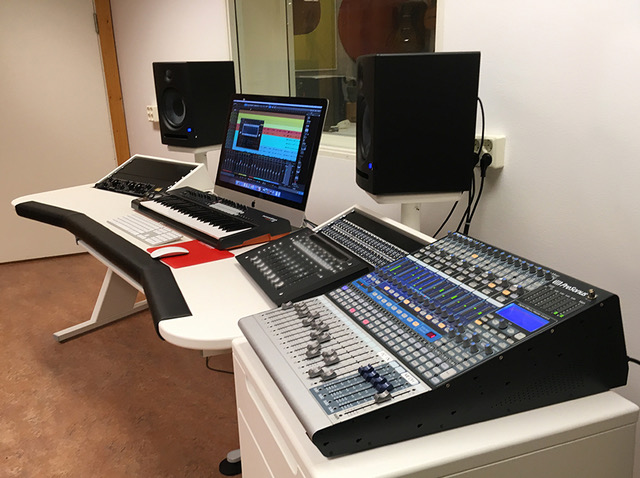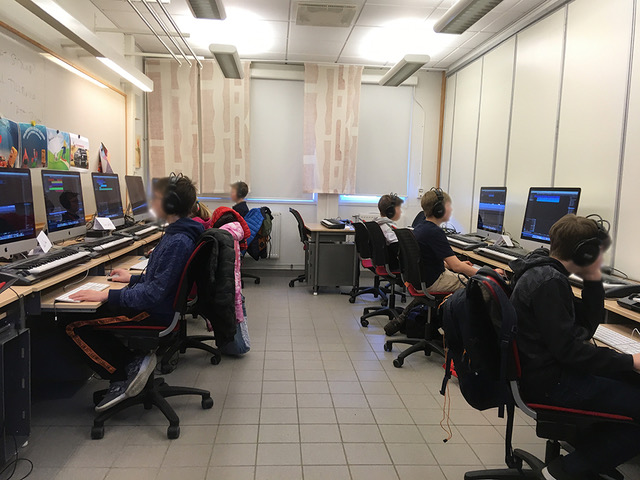Category Archives: Special Guest Post
Guest Blog: Teaching Game Music with Nikola Nikita Jeremić!
In this blog, we hear from PreSonus Artist Nikola Nikita Jeremić and his unique game design course at SAE Institute Belgrade!
If you have ever wondered how music for games is made, then SAE Institute in Belgrade, Serbia is the place to go! PreSonus and SAE Institute Belgrade have partnered together to bring the best audio tools for everyone who’s attending Nik’s course.
The person who will teach you about the exotic world of interactive game music, is none other than PreSonus artist, Nikola Nikita Jeremić. You may have read our interviews with him about his creative approaches to his soundtracks for Starpoint Gemini series of games, so Nikita decided to gather all of his vast experience on this subject and create two 2-month courses on how to compose game music from start to finish.
Nikita approached PreSonus on behalf of SAE Institute in Belgrade with desire to teach his lessons in Studio One, so we were more than happy to provide Studio One licenses for all of his students at the course so they can use them from the comfort of their home studios.

The course is divided in two parts, basic and advanced, and each one is two months long. The lessons are held online via Zoom due to the COVID-19 pandemic.
The basic course concentrates on basics of game music production and vertical layering, but also serves as the training course of basics of music production in Studio One and all of the benefits that Studio One offers to composers working in game and film industry. The course is based more around practical lessons than theoretical approach, so students have a hands-on experience on how to create their own interactive game soundtrack in its basic form and how to implement it via audio middleware.
The advanced course is expanding on the subject of the basic course and going really deep into the advanced techniques of how to create your own composing and mixing template in Studio One, specifically for game music production, with even more practical example on virtual orchestration and hybrid music composition and sound designed elements.
After each course, students are required to create their own compositions by using virtual and live instruments, edit the tracks, mix them and prepare them for implementation via audio middleware in order to get their licensed certificates from SAE Institute.
This is the first course of its kind at SAE Institute Belgrade, since June there are already 11 graduates of basic course, and now, starting from 17th of September, there are 18 students attending the advanced course.
All of us at PreSonus are looking forward to more graduates from SAE Institute who will become game music professionals on Studio One, and we are happy to be a part of their education!
Guest Blog: Solving Remote Teaching with Mats Nermark
- a pdf with ”Getting Started” instructions
- pdf sheet music with standard notation and tab
- a recorded version of the tune
- the same tune ”minus 1” to use a s a backing track (see more later)
- a video where I explain the different steps in this particular lesson package
- 1. First I have selected a tune with a fairly simple melody that every one can play as long as they can read a tab.
- And everybody should learn how to play simple melodies with expression and phrasing. You can’t get enough of that in my book.
- 2. A simple strumming accompaniment
- 3. A more advanced strumming accompaniment
- 4. A finger picking or stylistically appropriate accompaniment
- 5. Improvisation, what notes you can use and why. Stylistic tips and trick. This ties in with music theory, knowing your scales and how chords are constructed, etc.
Here is an example of one lesson pack broken down! (Lesson Example Files: Click Here)
- Step 1: For example, I selected Freight Train in C. Simple melody enough for the beginner to get around but also a good base on which to start a discussion with the advanced students about phrasing and the importance of the pause and space.
- Step 2: It also a song that’s easy to strum around a camp fire when camping, so we introduce basic strumming.
- Step 3: I then created the backing track as a country tune which allows for some more advanced strumming.
- Step 4: This brings in comping in the style of Luther Perkins who was the guitar player with Johnny Cash for many years.
- Step 5: This is unlimited in scope as there’s improvisation in the country context with stylistic elements like chicken picking, double stops, playing in sixths, and the importance of practice alternate picking.
Thanks again to Mats for contributing! For More on Mats Nermark, Visit his website at: www.nermark.com
Interested in submitting a guest blog? Contact us at musiced@presonus.com
Guest Blog: What Do You Need to Start a Class with Mats Nermark
Today we have a special guest blogger, our great friend Mats Nermark from Sweden! Mats is a long time PreSonus user and has led the way in his area with his approach to education! Let’s hear what Mats has to say this week!
What Do You Need to Start a Class?
Unfortunately, there’s always a cost associated with starting a project like a class in Music Production or just wanting to incorporate modern music technology in your regular classes.
The trick to make the budget people happy is obviously to keep the cost down, but what do I need at a minimum without compromising my goals and ambitions?
Here’s my list of what I would get.
For each student workstation:
- A computer
- PreSonus AudioBox iOne
- PreSonus Studio One Artist (included with the AudioBox iOne)
- A USB keyboard
- Headphones, like the PreSonus HD-7
For the teacher workstation:
- A computer
- PreSonus AudioBox iTwo (this interface has two inputs so the teacher can record in stereo)
- PreSonus Studio One Artist (included with the AudioBox iTwo)
- A USB keyboard
- Headphones, like the PreSonus HD-7
- Two microphones so the teacher can teach about recording and lend them to students for their recording needs in class. Usually not practical to record more than one thing at a time.
- A pair of PreSonus 4.5 studio monitors so everyone can listen to examples/demonstrations during classes.

I will be back with more posts about what I teach, how I do it and why I love teaching in this field. Hope to see you then!
Mats Nermark
Guest Blog: Choosing Software with Mats Nermark
Today we have a special guest blogger, our great friend Mats Nermark from Sweden! Mats is a long time PreSonus user and has led the way in his area with his approach to education! Let’s hear what Mats has to say this week!
Important Points to Consider When Choosing Software
There are a number of points to consider when choosing what software to use in your educational endeavor.
This list is not in any order of importance as your situation is probably different from mine. But please don’t disregard a point as irrelevant until you’ve really thought about it as it may become important at a later point.
- Does it have all the functions you need to use for all the people involved in your classes? Students, teachers and other contributors?
- Is it easy to teach? I have been working with most of the bigger name DAWs and find Studio One with almost everything being drag-and-drop or editable with the mouse scroll wheel being so easy to teach and for my students at all ages being able to grasp.
- Is it platform independent? Your DAW should work on both PC and Mac.! Why? Overall it’s not smart to shut anyone out who doesn’t happen to have access to a certain computer platform. For me it’s a matter of democracy. In Sweden, where I live and work, Mac computers are more expensive than PCs and PCs are also much more used in corporations. So it’s much more usual for students to have access to a PC at home than a Mac. But I certainly don’t want to shut out Mac owners either as the Mac is a nice computer.
- Is it made by a stable and reputable company? Freeware always seems to be a good deal at first glance, but freeware means that the people making it may find themselves in a situation where they have to focus on other things leaving you in a bind. When a larger company offers freeware, it’s often in the hope that you will get into the product to a degree that you will want to pay at a later date.
- Is it expensive? Studio One is available in three versions. Studio One Professional is on par with the other professional DAWs with the added bonus of Melodyne included in the package. Studio One Artist is less than $100 and contains all the functions, audio processors and virtual instruments I need to teach a class at almost any level. The really cool thing is that if you buy any PreSonus audio interface you’ll get a license for Studio One Artist for free. This license is valid for installation on five computers. Then there’s Studio One Prime that’s absolutely free and includes unlimited MIDI and instrument tracks and a virtual instrument covering all the basics. So all the students can download it for free and use for homework and their own musical enjoyment.
- Can you buy it? This may seem a stupid question but it really isn’t. I personally don’t like subscription models, as they are a cost that may be hard to estimate over time. Managers and budget decision makers usually want a firm number.
- Is the license transferable? If the computer breaks down, can I transfer the license to another computer? If a teacher quits, can I transfer the license to another teacher’s computer?
- Is material and knowledge portable between the different levels of the software? Can a student take what he/she has done during class in Studio One Artist and bring it home to work in Studio One Prime. Yes, with a little planning, this is easy. If the student has used a fx or instrument plugin not available at home then the Bounce function is very easy to use and renders instrument tracks and fx to audio which can be played in all versions.

In Kungsbacka, Sweden, we have decided to use PreSonus Studio One as it fulfills all our requirements and ticks all the boxes in the list above. So in our classes in Music Production and Computer As A Musical Instrument our students get to learn with Studio One Artist in a class room environment and they take that knowledge with them back home to work with whatever setup they have. Once they have reached a certain level of proficiency they also have the option to book our studio where we have Studio One Professional and a number of plugin packages.
I will be back with more posts about what, how and why I love teaching in this field. Hope to see you then!
Mats Nermark